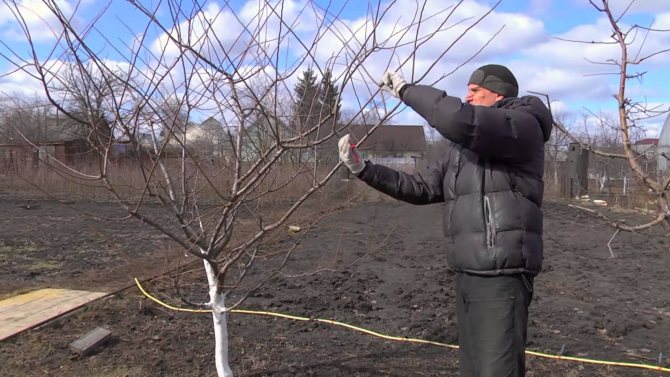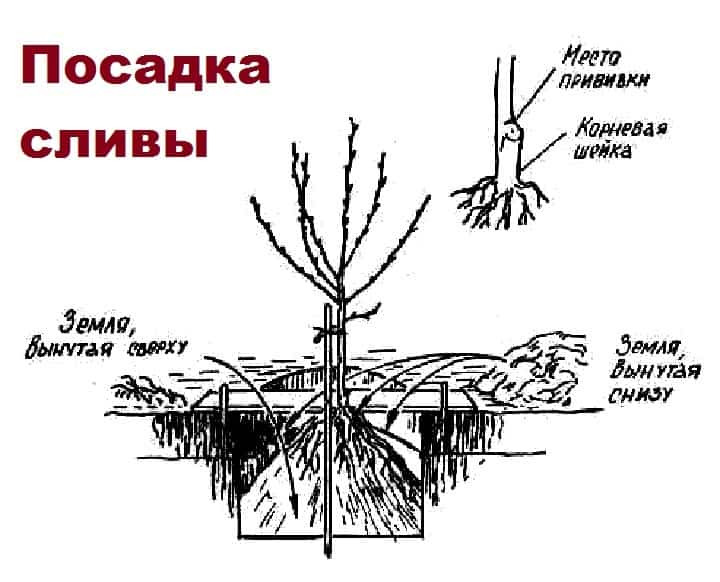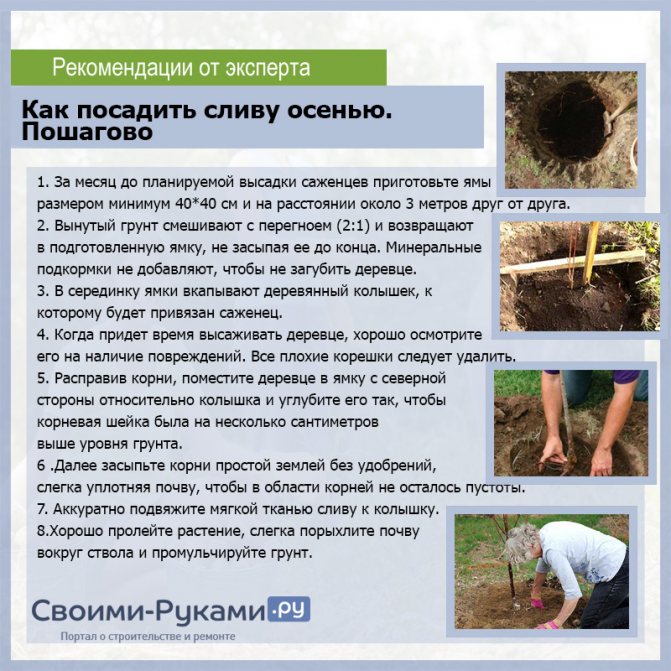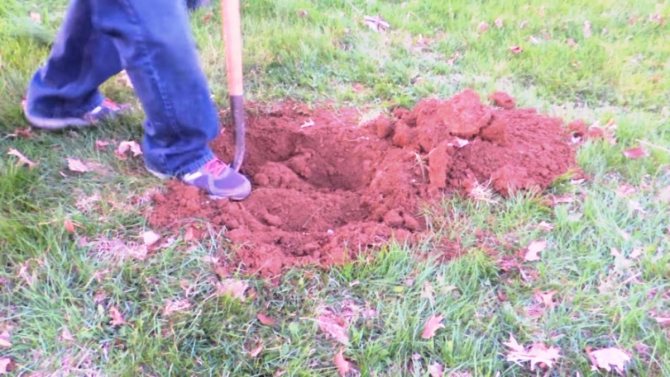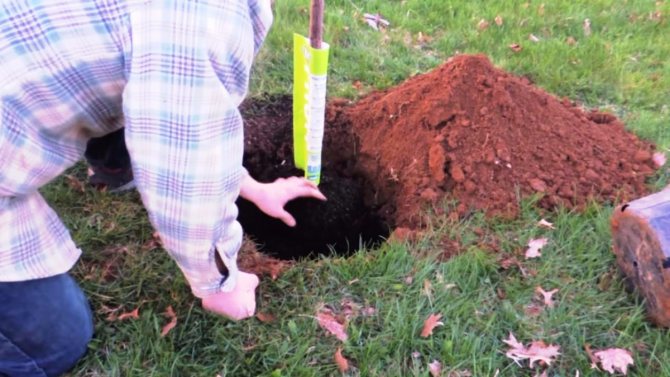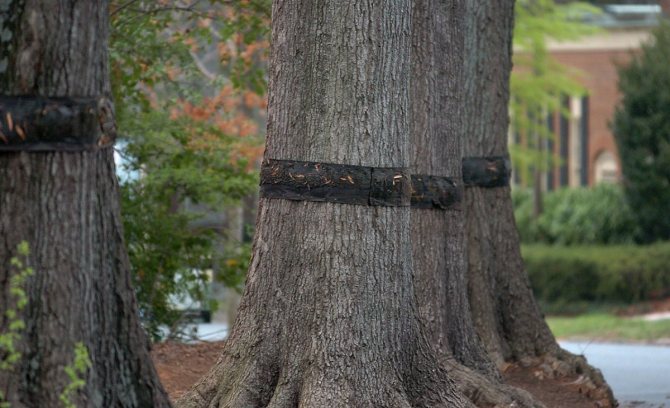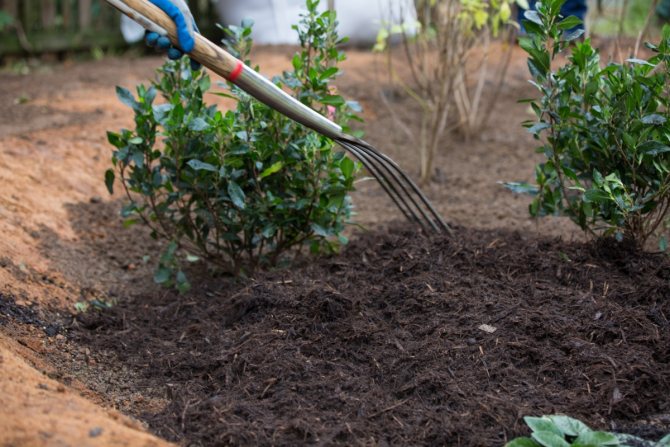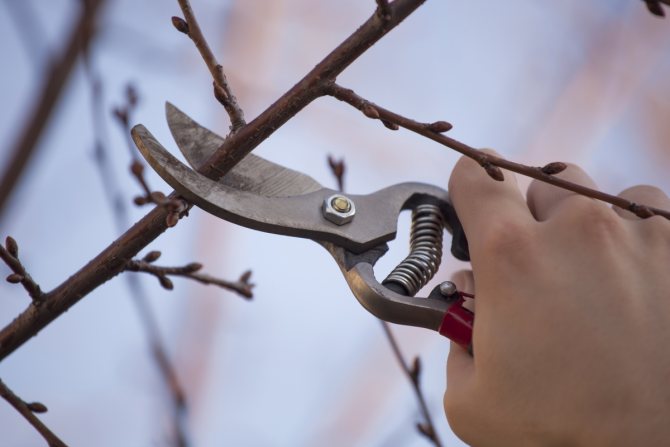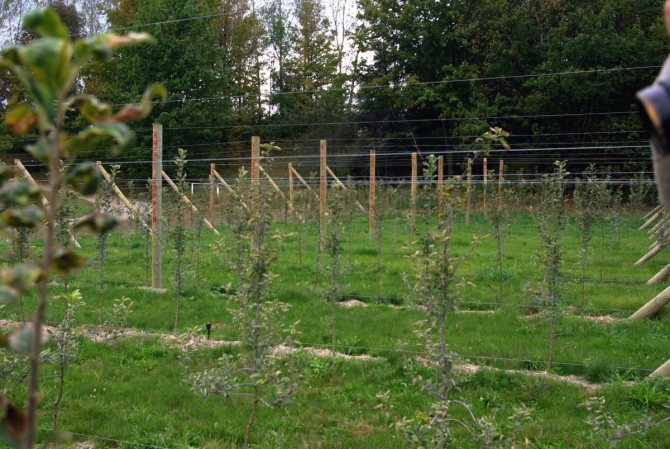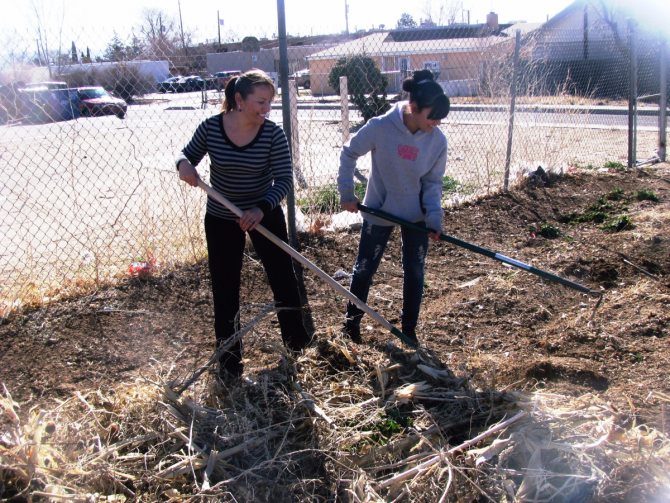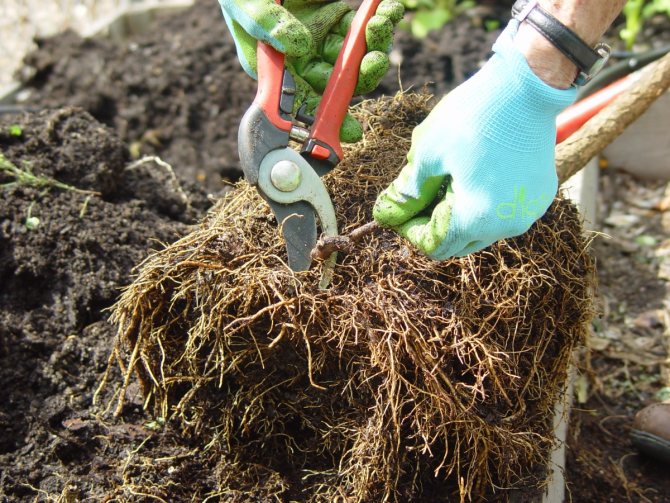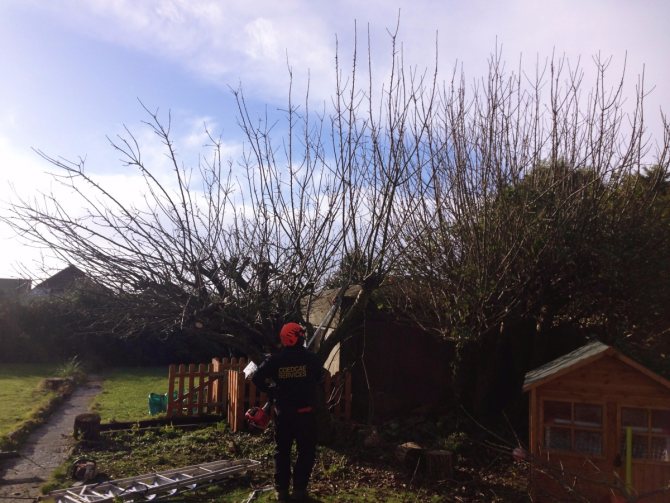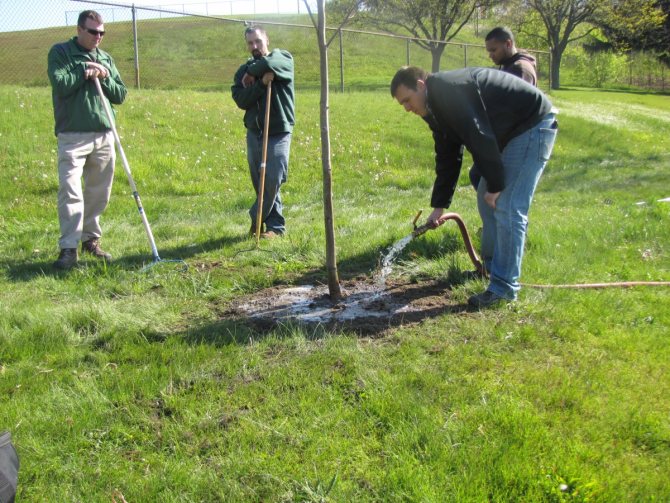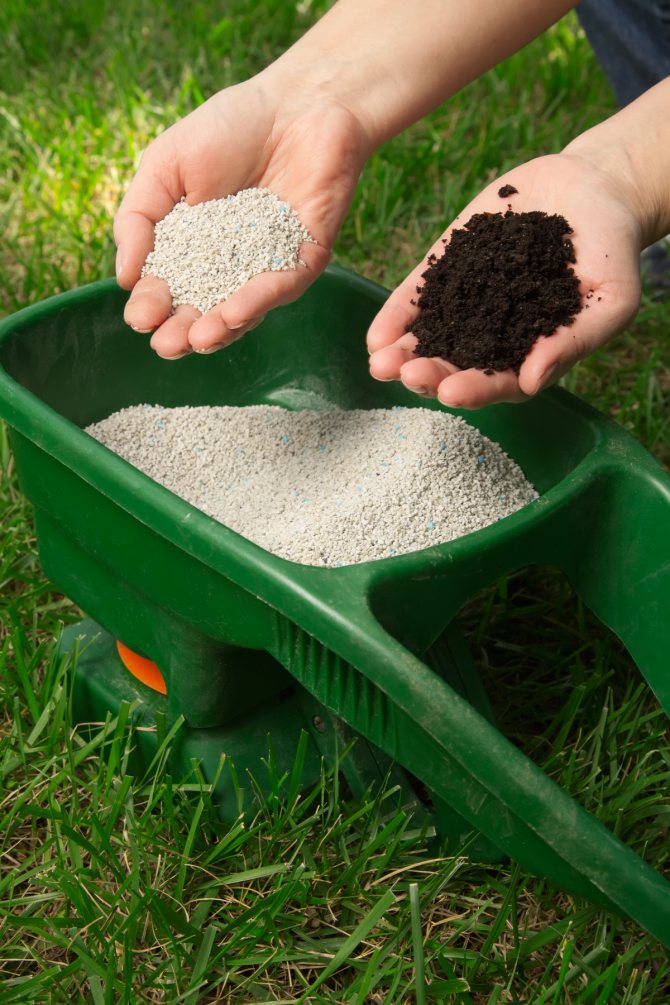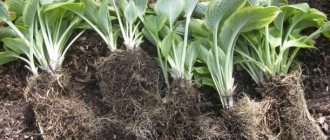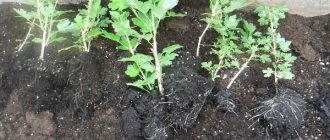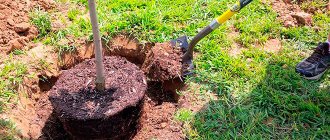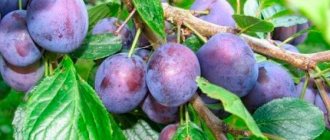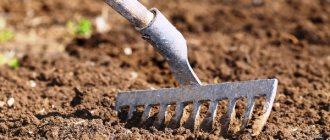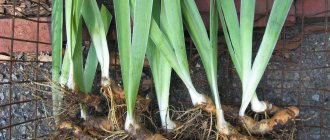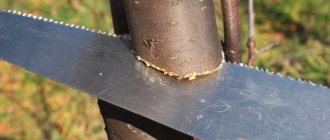You can talk for a long time about the beneficial and taste properties of plums, these trees are found in many garden plots. However, like any plant, agricultural technology has its own characteristics. Planting plums in the fall is the best option for the tree to take root well and bear fruit abundantly.
Why is it better to plant it during this period, how to prepare the site, than to feed it, how to prune and protect it from pests and diseases? It is important to understand these issues so as not to be mistaken with the variety and growing methods in a particular region.
When is it better to plant plums: features of spring and autumn planting
In order for the tree not to freeze in winter and to start growing quickly by the arrival of heat, it must be planted at such a time that it has time to take root well before the onset of summer heat and severe frosts. So, in the spring, the plum is planted in late March-early April, when the sap flow has not yet begun, and in the fall - in September, about a month before the establishment of cold weather.
Autumn is considered the best time for planting plums. Planting at this time has several advantages:
- Large assortment of fresh planting material.
- Seedlings do not respond to root damage
The main disadvantage of planting plums in autumn is that the seedling needs to be covered for the winter, otherwise it may freeze out.
Planting in the spring also has its pros and cons. The only advantage of spring planting is that during the season the seedling takes root well and tolerates the winter safely.
It is undesirable to plant a tree in spring for the following reasons:
- Many seedlings, due to a long stay with the seller, bloom even before the time of planting. Such weak plants get sick after planting in the ground and die after a while.
- It is difficult to get planting material of the required type.
- Since the plum wakes up early from winter sleep, you may not have time to plant the plant before the start of sap flow.
According to the lunar calendar in 2020
Choose the optimal date for planting seedlings can help you Moon calendar.
So favorable days for planting plums in 2020 according to the lunar calendar
are:
- in April - 11-17; 21-26.
Yes, this is not a mistake, seedlings of fruit and berry crops according to the Lunar calendar are recommended to be planted in spring only in April.
- in September - 17-24, 30;
- in October - 2-4, 12, 13, 21-25, 30, 31.
Of course, it is not always possible to get to the dacha on favorable days, therefore, the main thing is not to land on unfavorable days.
Unfavorable days on the lunar calendar for 2019
for planting plum seedlings, the following dates are:
- in March - 6, 7, 21;
- in April - 5, 19;
- in May - 5, 19;
- in June - 3, 4, 17;
- in July - 2, 3, 17;
- in August - 15, 16, 30, 31;
- in September - 14, 15, 28, 29;
- in October - 14, 28;
- in November - 12, 13, 26, 27.
According to the lunar calendar from the magazine "1000 Tips for the Summer Resident".
How to plant a plum: features and step-by-step instructions
Before running headlong for a seedling, you need to carefully study all the rules for planting a plum. What do you need to know?
Video: correct phased planting of plums
What should be a seedling
When choosing a planting material, first of all, you need to pay attention to its origin. It is best to choose zoned varieties that are adapted to the weather conditions and soil composition of the growing region. Seedlings from other regions are not recommended for planting, since in most cases they do not tolerate prolonged low and high temperatures, grow slowly and die within a short time.
Since plums are divided into those that themselves are pollinated and those that need other trees of this species for pollination, you need to decide on the method of pollination. To do this, you need to take into account not only your own desires, but also the amount of free space on the site.
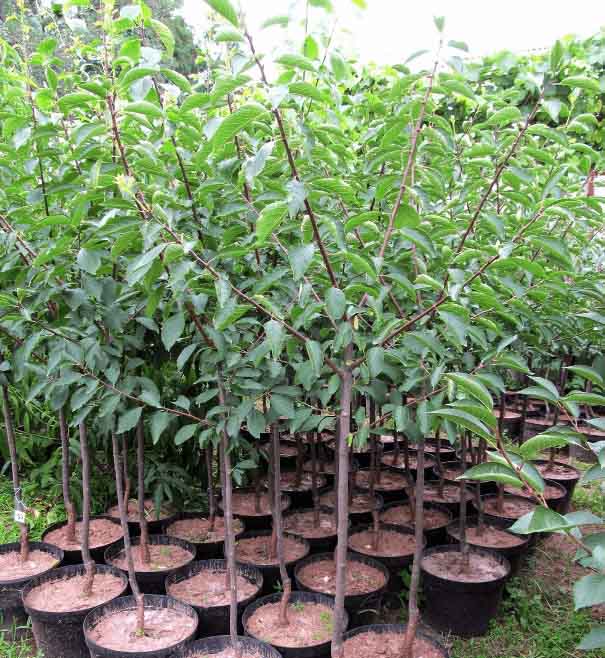
It is equally important to inspect the appearance of the seedling. The first step is to assess the condition of the rhizome: it should be well developed with a central conductor of medium length. A normal root system should consist of 4-5 shoots, the length of which is more than 25 cm.
Important!
You should not buy a seedling whose conductor is cut too short.
The thickness of the trunk of a young tree should be 1-2 cm. In some varieties, the thickness of a 2-year-old seedling may be more or less by a few millimeters.
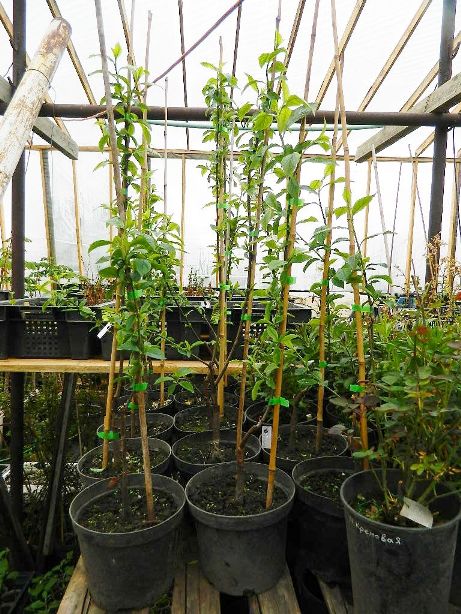

For planting, it is best to use trees that are one or two years old.
Pick-up location
In order for the seedling to develop well and bring delicious fruits in the future,
it is very important to place it in the right place. It is necessary to plant a plum in well-lit areas or in a small partial shade, only here it will be able to form high-quality fruits,
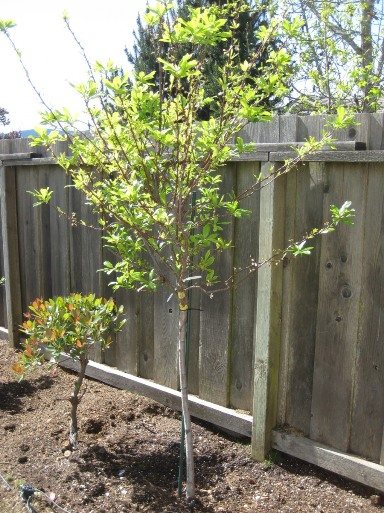

Do not plant plums in lowlands where water stagnates for a long time or in places where groundwater flows close to the surface. Plum growing in such conditions often suffers from fungal diseases, which is why it does not bear fruit well.
What to plant with
According to the map of combining trees and shrubs, the plum cannot be planted next to pear, cherry, cherry and walnut
... According to the observations of experts, trees planted nearby inhibit each other's growth and bear fruit poorly.
At what distance
The distance between trees depends on their type. In order for large specimens of plums to have enough space, they are planted with a step of 3-4 m, trees of low-growing varieties are planted at a distance of 2.5-3 m.
Important!
When drawing up a site plan, you need to take into account the fact that many varieties are not capable of self-pollination, so they should be planted only in groups.
What soil is needed
The ideal environment for growing plums is loamy soil, the acidity of which is 6.5-7 units. You can determine the acidity of the soil using litmus paper. To do this, take a handful of wet earth after rain and apply a test paper to it. If it turns pink, the soil is neutral or alkaline. Red color indicates that the environment is acidic.
In this case, the soil must be lashed before planting: pre-add slaked lime or dolomite flour to the site.
To improve the sandy or peaty soil, a layer of clay 10 cm high is poured into the pit.
How and what to fertilize before planting
Even the highest quality seedling will take root for a long time if the soil is poor in micro and macro elements. To prepare the substrate, the following substances are added to the soil:
- 2 buckets of humus or compost;
- 2 buckets of peat;
- 1 tbsp. superphosphate;
- 3 tbsp potassium sulfate;
- 3 tbsp urea
You can fill the planting hole with a simpler mixture. 2 cups of nitrophoska and 200 g of wood ash are added to the fertile land. The last substance can be replaced with the same amount of fluff lime or dolomite flour.
After combining all the components, the mixture is thoroughly mixed.
What depth to plant
A week before the expected landing date, a hole is dug at the selected place with a diameter of 70-80 cm and a depth of 70 cm. When arranging a place for landing, the top layer of earth is folded on one side, and the bottom layer on the other.
If the soil on the site is heavy, the bottom is loosened to a depth of 20-25 cm. Then the fertile soil taken from the heap where the top layer of the earth was folded is mixed with fertilizers.
A wooden peg 110 cm high is thrust into the bottom of the planting pit at a distance of 2 cm from the center.
Crushed eggshells are poured onto the bottom and covered with 2/3 of the prepared substrate. If there is not enough mixture, fertile soil is poured into the pit.
Important!
To prevent young wood from drying out, the root collar should rise 3-5 cm above the ground.
Landing technology
After all the necessary preparations, the plum planting procedure is as follows:
- After spreading the roots, place the seedling in the hole and deepen it so that the root collar is a few centimeters above the ground.
- Fill the tree with soil, without admixture of various fertilizers.
- Then the ground around it needs to be tamped very well so that no air remains near the roots (it can cause the horse system to dry out).
- From the soil that was dug from the very bottom of the pit, a small embankment is made around the tree, which will contribute to the excellent water absorption of the seedling.
- Next, a garter is performed to the peg.
- The final touch is carried out - a thorough shedding of the plant.
Video: how to plant a plum
Outcomes
It is better to plant plums in spring - this way the seedlings will have time to take root and prepare for wintering in comfortable conditions. But if you still got young fruit trees in early autumn, you can plant them in a permanent place:
- choose a place for drains that is well lit during the day;
- dig a planting hole and fill it with a mixture of excavated soil and three-year compost;
- set the seedling on a mound of earth and sprinkle with soil so that the root collar remains above the ground;
- spill the seat well.
In order for young trees to endure wintering well, they must be covered with the onset of cold weather and the first snow falls with straw or peat, and in the spring, with the first thaws, the insulation should be removed.
Care after landing
In order for young trees to take root in a new place, they need to create the most comfortable conditions. Seedling care includes the following manipulations.
Watering.
Due to the fact that the plum prefers to grow in a humid environment, the soil must be regularly moistened. It is especially important to irrigate after spring planting, since after the arrival of heat, the soil quickly dries up, and the young tree may die.
In the future, in dry weather, the tree is watered once a week. The volume of water should be such that the soil at a depth of 40 cm is moist. Following this rule, the water consumption for watering a young tree is 40 liters, for an adult - 60 liters.
Important!
You cannot turn the soil around the plum into a swamp. Excess moisture is the main reason for the development of fungal diseases and cracking of fruits.
In order for the tree to feel normal, in winter you need to monitor the thickness of the snow cover. If the snow near the seedling is more than 60 cm, it is removed.
Top dressing.
Young trees begin to feed at the age of 2 years. In the spring, an organic solution from mullein or droppings, prepared at the rate of 1:10 and 1:20, is introduced under the plum. Fans of mineral fertilizers feed plums with urea or complex mixtures with a high nitrogen content. In autumn, the tree is fed with phosphorus and potassium fertilizers: 100 g of potassium sulfate or superphosphate.
Pruning.
In order to form the correct crown, the seedling is cut immediately after planting. In the first year, the central conductor is shortened to the level of 1-1.2 m, in the second, the strongest branches are selected and cut to a length of 25-30 cm.At the age of 3 years, the apical growths are shortened by 30 cm, the lateral ones by 15 cm ...
At the end of the formation, the crown should consist of 5-6 strong branches located at an angle of 50 degrees. In the future, shoots are annually removed, which thicken the crown, as well as dried, diseased and damaged branches.
Loosening.
After each watering or heavy rain, the soil around the seedling is carefully loosened.As a result of this manipulation, more air enters the roots, and the plum grows faster.
Mulching.
To prevent moisture evaporation and the growth of weeds, as well as to protect the roots from freezing, the near-stem circle of a young seedling is covered with humus or compost. Organic substances not only cope with the above functions, but also replenish the stock of micro- and macro-elements of the soil for a long time. The mulch should cover the soil above the rhizome, but should not touch the trunk.
Shelter.
The tree planted in the fall is not yet strong enough to withstand the winter cold without additional protection, so in the first year it must be covered. On the eve of cold weather, the trunk circle is mulched with a layer of straw, which is covered on top with sheets of thin metal or slate. The trunk of the seedling is wrapped in burlap or dense material.
Read more about preparing plums for winter and leaving in autumn - read pruning and shelter.
Video: how to care for a plum
Growing and caring for plums
In order for the plum to please with crops, you need before growing:
- not only choose the right varieties, but also choose the types of pollinators;
- determine the correct planting site, timing, choose a good seedling;
- observe all the necessary techniques and agricultural techniques for plum care.
Plum dressing
The development of plums during cultivation is stimulated by top dressing. For the first 2-3 years after planting, the plum will have enough substances introduced during the laying. Then fertilizers alternate: for a year the plum is fed with organic matter (infusions of mullein, bird droppings, slurry, compost, herbal "brilliant green"), for a year - with mineral salts (in April, before flowering, - 15–20 g of carbamide per 1 m², in May, after flowering, - 20 g of double superphosphate + 30 g of potassium sulfate per 1 m² of the trunk circle). From inorganic plums, phosphorus and potassium are needed (for root development and the formation of beautiful fruits).
How to water a plum
In spring, there is enough moisture in the soil, and the plum does not need watering. She needs it during the period of fruit ripening, from June to August inclusive. Watering rate - 50 liters per 1 m². The wet care schedule is approximately as follows:
- immediately after landing;
- during the formation of the ovary and the growth of shoots;
- a week before harvesting the fruits;
- after harvest (if the summer is very dry);
- in October (if autumn is warm and there is a need for it).
In this case, it is necessary to follow some rules of wet care:
- The plum is not watered just before the ripening of the fruit. From an excess of moisture, the peel will burst.
- Do not allow the soil to dry out, this is dangerous for the plum. Both ovaries and leaves will fall off, as a result of the plum, they may die.
- The best care in hot weather is watering at the root.
Pruning plum
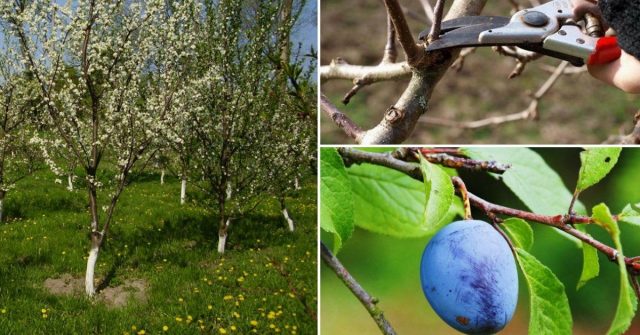

Pruning care is carried out in March, early spring. Trees are formed in tiers (3-3-2 skeletal branches). The distance between the branches is 15 cm, between the tiers - 50 cm.The height of the trunk is 40 cm.
The developed branches of young plums with a length of more than 45 cm are shortened by 1/4 of the length to stimulate the formation of shoots. During fruiting, the crown is rid of dry and thickening branches.
- If the growth is weak (10-15 cm), then rejuvenating pruning is carried out on the 5-year side branch.
- Every year, in early spring and autumn, plum shoots are removed, cutting them to the base of the root system.
Mulching
Mulching when growing plums is carried out to maintain the quality of the soil. It prevents the formation of an earth crust and prevents moisture from evaporating quickly.
Mulch for plum care is organic (sawdust, shavings, cut grass, hay, needles, moss) and inorganic (newspapers and films). Its functions are as follows:
- insulates the entire underground part of the plant;
- reflects the sun's rays;
- prevents the soil from drying out, retaining moisture;
- prevents weeds from growing.
Plum, when grown, forms more adventitious roots if mulched. Before this type of care, top dressing is carried out.
Landing features in different regions
In order to plant a plum correctly, amendments must be made to the general planting recommendations, which are caused by different weather conditions and the state of the soil of a particular region.
In the Volga region
Due to the fact that winter in this region is not characterized by severe frosts, plums are planted in spring in late March-early April, and in autumn in mid-September. For planting, it is recommended to use varieties resistant to moniliosis and clasterosporium.
In the middle lane (Moscow region)
Plum planting in spring and autumn in the Moscow region is carried out according to the above recommendations, without any peculiarities.
In Siberia and the Urals
In the north, plums are planted in the open ground in April in the spring, immediately after the soil has thawed. Since there is a high risk of freezing, a fruit tree is usually not planted in the fall. Only zoned frost-resistant varieties are used as planting material.
Video: how to plant a plum sapling in Siberia and the Urals
Optimal growing conditions
After planting, the first 7 years of fruiting is weak, after 12 years the period of the highest yield begins. Based on this physiology, it is necessary not only to acquire, but also to create living conditions. The correct growth and acceleration of the onset of intensive fruiting depends on this. Lowlands are not suitable for trees, in which cold air accumulates in spring and autumn, it has a detrimental effect on plants. A good place would be the border of the site along the fence or next to the house, which will protect from the wind, but not in the shade. Drought has a bad effect on fruiting; during dry periods, watering is organized. The optimal pH of the earth is in the range of 6.4–7.2. Plum is afraid of high standing groundwater. Therefore, if they are at a depth of less than 1.5 meters, you can plant a plum in the fall on specially prepared high beds, or organize a drainage of water from the site.
Possible mistakes when planting plums
Even in such a simple matter as planting a plum, novice gardeners manage to make a few mistakes. Here are the most common ones:
- Plum is planted at an angle.
- Trying to create comfortable conditions for growth, they add excessive amounts of water and fertilizers.
- The growth force of the selected variety is not taken into account and low-growing and vigorous plants are planted at the same distance.
All that is needed for the correct planting of a plum is a little time to study the technology and put it into practice. Already after a few years, the plum will certainly fully thank the owner for the care rendered with an abundant harvest of sweet fruits.
Video: how to grow plums
Plum transplant in autumn
will enable the root system to successfully take root in a new place. Next spring, the young plum will develop effectively, which will ensure a good harvest of fruits in the near future. Agricultural technicians recommend using plum saplings no older than five years for transplanting.
Goals and objectives of transplant
Sometimes it becomes necessary to transfer adult culture to a new place. The goal could be:
- Plum placement in a more favorable place where there is a possibility of pollination, optimal lighting conditions and soil parameters;
- appropriation of a tree growing in an abandoned territory, not needed by the previous owners;
- abstraction of root growth of a suitable variety;
- removing a tree from the site where construction is planned;
- moving your favorite varieties from the old site when moving to a new place of residence.
The main task is to relocate the plum so as not to harm it by careless actions. The transplant must be carried out in accordance with all the rules. Plum is not capricious, it is poorly susceptible to stress, it is subject to resettlement at an age when its adaptability is maximal. Caring for a transplanted tree is not easy, but it is essential to maintain a healthy crop.
Plum transplant dates in autumn
When is the best time to transplant plums in the fall?
Plums are transplanted in the second half of the autumn period. In October, the air had already cooled, and the ground had not yet frozen.The new tree will avoid the danger of sprouting that frost can kill. And he will be able to take root in a land warm enough for this.
Preparing for transplant
Plum seedlings are prepared for transplanting as follows:
- Watering. Up to five buckets of water are poured under the sink.
- Digging. The plum is dug by digging around the trunk. At the same time, seventy centimeters recede. And they cut out a cone-shaped piece of earth, plunging into the depth of the same seventy centimeters.
- Transportation. The plum with an earthen cone is separated from the soil, trying to keep the clod around the roots intact. The lower part of the plum is wrapped with a film or a bag, tied with wire (rope). The packaged seedling is delivered to the transplant site.
Proper preparation for winter
Winter preparations should begin a few weeks before the onset of cold weather... For each plum, it is necessary to apply fertilizers: per square meter of land, you will need a bucket of humus, 200-300 grams of ash and 30 grams of superphosphate or potassium sulfate.
Fertilizers must be slightly dug in, loosening the ground, and watered abundantly.
Then you need inspect the crown and trunk, removing all pests... The spoiled leaves and branches are cut and burned away from the trees, the spoiled bark is cleaned off with a scraper and a wire brush.
In the process, you need to be careful not to touch healthy areas.
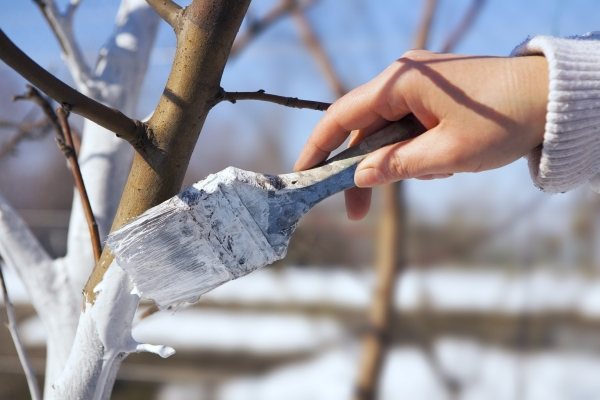

For wintering, the plum is fertilized, pests are removed, the trunk is whitened and covered, the soil is spud and manured
After falling leaves to protect against insects the barrel is whitewashed with a special solution from a store or a mixture of equal parts of lime, clay and cowshed. You can also add copper sulfate - 30 grams per liter of whitewash.
Just before the frost the trunk is insulated with burlap or straw... If winter promises to be cold, you can use slate or roofing felt. If the bushes are still small, you can cover them on top with a bag or spruce branches, make a "hut" of boards.
Any "shelter" must be carefully secured so that the wind does not blow it away. The soil under the tree is spud and spread with manure.
How to properly transplant plums in the fall
Plum transplanting is technically simple:
- Pit parameters. The size of the hole should be a couple of tens of centimeters wider and deeper than the earthen cone around the roots of the plum.
- Top dressing. The bottom of the pit is filled with compost.
- Installation. The plum is lowered into the pit, setting it so that the section of the "root collar", the place between the root and the trunk, is at the level of the ground.
- Backfill. The plum falls asleep, filling the hole completely. Simultaneously with backfilling, it is watered until the soil is moistened.
- Wind protection. A thin plum is strengthened by tying it to a strong stake.
- Mulching. The place under the drain is poured with soil and covered with a layer of ash mixed with peat or sawdust.
Plum, along with apples and pears, is extremely popular with gardeners - it is unpretentious, cold-resistant, takes root well and bears fruit not only in the southern regions, but also in the central zone. Sometimes we need to transplant an already mature tree to a new place. This is easy to do, but you should follow the basic rules and conditions of the transplant.
The plum should be transplanted in early spring or in the autumn, when the tree "falls asleep" and all its life processes are suspended - then it is less traumatic for it. If you need to transplant plums in the fall, it is better to do this at least 30 days before the first stable frosts, which can destroy the roots of a plant that has not yet taken root. In a temperate climate in the middle zone, where early frosts are not uncommon, it is recommended to replant trees only in spring.
Young plums survive the transplant best of all, overgrown trees older than 5 years are likely to tolerate this process poorly - their roots are significantly damaged, they weaken and get sick a lot.Preparing the soil for transplanting should be taken care of in advance: in three to four weeks, so that the earth has time to settle properly, it needs to be dug up, holes for the root lump should be prepared and filled with humus. The diameter of the holes should be at least 60 * 60 cm. Or slightly more, the depth should be at least 50 cm. With sandy, peaty soil, put clay on the bottom of the hole (layer 8-10 cm).
In a large garden or summer cottage, there will certainly be a tree that gives a harvest of sweet and fragrant fruits -. If the plum does not grow on your site, it's time to plant it. By the way, they usually do this in spring or autumn. Well, in our article we will talk about how to plant a plum in the fall.
Autumn planting of plums - choosing a place and time
Since plum is a light and thermophilic culture, small hills or hillsides where the sun's rays fall will be the best site for it. At the same time, the site must be protected from strong winds. The tree is suitable for fertile, but at the same time loose soil. Wetlands and lands with groundwater above 1.5 m are not suitable for this purpose.
If we talk about when it is possible to transplant plums in the fall, then it is best to choose a day for this at the end of September, when there is still no frost. It is important that the sap flow slows down near the tree, but at the same time it has time to get used to the new place.
How to plant a plum sapling in the fall?
Two weeks before planting, you need to dig a hole up to 60 cm deep, with a diameter of about 80 cm. Fertilizers mixed with the excavated soil are placed at the bottom (a bucket of rotted manure, potassium salt 65 g, superphosphate 350 g). If the soil is dense, it can be mixed with sand to improve drainage properties.
When choosing a seedling, pay attention that the plum seedling has a strong root system. For planting, it is optimal to use a one- or two-year-old seedling. It is lowered into the planting hole, the roots are carefully straightened and the earth is covered, periodically trampling it down. It is important that the root collar was located at a height of 3-4 cm from the ground level. If necessary, a stick is stuck into the hole for a tree, which will become a support for an unstable plum. Then the tree is watered and mulched with peat or.
If, due to circumstances, it is necessary to plant a seedling in late autumn, then for better wintering the plum must be dug in a small ditch obliquely and almost completely covered with earth, peat, and in winter also snow. And already in April, a young tree can be transplanted to a permanent place.
How to transplant plums correctly in the fall?
It so happens that the gardener needs to transplant an adult plum to another place, for example, more illuminated or closer to other varieties of plums, which will help to improve the yield. Keep in mind that only young trees under 5 years of age tolerate "relocation" well. Two weeks before replanting the plum in the fall, dig a hole in a new place and put fertilizer on its bottom. The tree is dug up together with an earthen lump. It is recommended to wrap the earthen lump tightly with damp burlap. Then the plum is carefully placed in a prepared hole along with burlap, covered with earth, trampled, watered with 1-2 buckets of water and mulched.
In the middle lane, it is difficult to find a personal plot on the territory of which a slender plum tree would not adorn. For a long time, the culture has been valued by gardeners for its unassuming disposition, resistance to the whims of a changeable climate and, of course, excellent productivity.
Plum fruits, the color of which, depending on the variety, varies from yellow-green to blue-black and purple-violet, are well known to many not only as a delicacy, but also as a healing product.
Ripe plums with a lot of useful properties are recommended to be included in the diet for disorders of the digestive system, heart disease, anemia, kidney damage.
Subject to the norms of agricultural technology, the culture rarely requires special attention from its owner.However, sometimes, for example, when redeveloping a garden area, the tree must be transplanted, as a result of which many questions arise. When to replant plums, in autumn or spring? How to do it correctly so that your pet can easily endure the procedure. Let's consider the culture transplant technology in detail.
Terms of work, location of the drain on the site
The optimal time for the event is the beginning of spring, until the buds woke up and sap flow began, or early autumn, from about September 15 to October 20. Depending on the weather conditions of the cultivation region, the timing of plum transplanting may shift in one direction or another.
In case of emergency, it is allowed to carry out the procedure in late spring or summer, but the plants tolerate such interference in the process of their development is extremely difficult and will not bear fruit in the current season.
If, in the process of transplanting, the root system of the tree suffers, then the break may drag on for another 1-2 years. One way or another, the question of when to transplant a plum is decided by the gardener himself, taking into account all the circumstances and external factors.
Before transplanting a plum, a suitable place should be chosen for it on the site - bright, sunny, closed from through and cold winds. The plum has a minimum of requirements for the soil - the main thing is that they are not too acidic.
Undesirable close passage of groundwater, the optimal depth of their occurrence is at least 1.5 m from the surface. Regardless of self-fertility or self-fertility (both of these concepts are very conditional) of the transplanted tree in the neighborhood, it is advisable to plant another 1-2 plums. Group planting is a great technique for increasing yields, but the timing of flowering of neighboring plants should be the same.
We buy seedlings
It is best to buy plum tree seedlings in specialized nurseries for growing garden plants, since in spontaneous markets there is a high risk of running into a sick tree or being deceived and buying the wrong variety that you would like. In nurseries, plums are most often sold on the so-called seed rootstocks - these are rootstock plants sprouted from seeds, to which a scion is grafted - another plant. Thus, we get that very tree, which will then give us fruits. Trees grown from these seedlings begin to bear fruit early and abundantly.
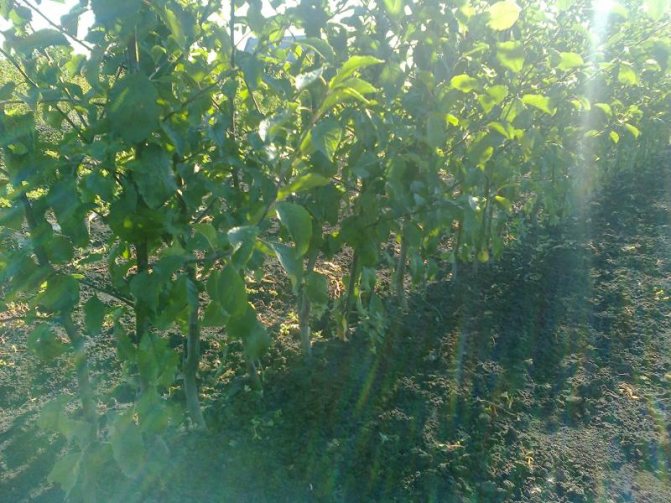

Plum tree saplings are best bought in specialized nurseries for growing garden plants.
Also, sometimes you can purchase own-rooted seedlings, that is, those that are grown from root shoots or cuttings. They are good because in the event of a tree freezing, it can be restored, and it is also convenient to grow seedlings on your own.
It is best to choose plum seedlings that meet the following parameters:
| Parameter | Numerical value |
| Age | 1-2 years |
| Plant height | 110-140 cm |
| Barrel diameter | 1.1 to 1.3 cm |
| Trunk height before bifurcation | 40-60 cm |
| Barrel diameter at the level of 10 cm from the vaccination site | 1.3-1.7 cm |
| Branch length | about 15-20 cm for a one-year-old and about 30 cm for a two-year-old |
| Root system | About 4 roots from 25 cm long |
By following this table, it will be more convenient to choose the right plum saplings.


The main features of the plum
Which tree can be replanted
You can transplant a plum to a new place before the plant is 4-5 years old. The procedure is best tolerated by one-year-old plum trees and two-year-old seedlings.
After they have been transported to their permanent growth site, the root system should be carefully examined for damage. All broken off, rotten and dried out processes must be removed. If the roots of the plant are very dry, then the seedlings are recommended to be placed in warm water an hour or two before planting.
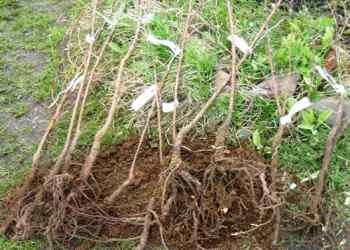

Very often, gardeners practice "relocation" of young root shoots, due to which the plum orchard expands.However, this measure is justified only if the offspring was taken from a tree with its own roots. The cultivation of a grafted plum shoot can bring unexpected results, since the offspring inherit the characteristics of the rootstock, not the scion.
Plums at the age of 4-5 years begin to prepare for transplanting in 10-12 months. At a distance of 70-75 cm from the base of the trunk, a groove is dug 50-60 cm deep, which is filled with a mixture of sand, peat, humus and plentifully spilled with water.
During this period, inside the entrenched circle, the plant will form new roots, thanks to which it will painlessly transfer the procedure. A year later, the plum is carefully dug out together with a voluminous lump of earth, chopping up the old roots with a shovel.
So that the soil does not crumble from the roots, the lump is tied up in burlap and the tree is transported to a new place. Before transplanting, the stem of the plum and the base of the skeletal shoots are wrapped in wet burlap for 15-20 days.
Transplanting a plum in old age is fraught with the death of the plant, therefore it is recommended to avoid such a risky event.
Specificity of further care
No matter what time of the year the transplant takes place, it is important to provide the plant with optimal care for full development and abundant fruiting.
The gardener needs to take into account that in the first seasons after transplanting, the shoots will stretch out chaotically, distorting the shape of the crown. Therefore, it is necessary to carry out formative pruning of the plum.
You also need to control the acidity of the soil. With an increase in acidity, neutralization with dolomite or lime should be carried out.
The transplanted plums should not experience a moisture deficit. Watering is carried out regularly, its frequency is determined by weather conditions, and decreases by the end of summer.
Preparing a place for planting plums
The future "place of residence" of plums is prepared in advance, observing the following procedure:
- The plot is dug to the depth of the shovel bayonet.
- Excessively acidic soil is alkalized by adding wood ash or dolomite flour at the rate of 600-800 g / m².
- They dig a hole with a diameter of 70-80 cm and a depth of about 80 cm, while throwing back the fertile soil of the upper layer on one side, and the poor lower one on the other.
- A high stake is driven in the center of the pit, which will later serve as a support for the drain.
- Fertile soil taken out during digging is filled with peat and humus and the resulting mixture is poured with a mound on the bottom of the pit.
- During spring transplantation, in addition to organic matter, superphosphate (250-300 g), potassium salt (45-60 g) and wood ash (300-400 g) are added to the soil.
The planting pit for drainage must be prepared no later than 2 weeks before the start of the main work.
On the appointed day, plum transplant work is carried out in several stages:
- The tree is placed in a prepared pit, leaving the root collar 5-7 cm above the soil surface.
- The voids between the walls of the pit and the roots of the plum are filled with the remaining fertile soil mixture.
- The soil around the base of the trunk is carefully trampled down and generously watered.
- Young plants are tied to a support stake with a loop-eight. Mature trees are attached to 3-4 stakes driven in a circle with guy ropes.
- After the procedure, the newly planted plums are watered with warm water with the addition of drugs that stimulate root formation.
Knowing how and when you can transplant a plum, it is not difficult to carry out the procedure, and a grateful tree, after adapting to a new place, will respond to the care with an excellent harvest.
Disembarkation
In autumn
When the preparatory work is completed, you can proceed directly to planting. Landing is carried out in the holes dug a month ago, according to the following algorithm:
- if the mound in the pit was not made in advance, it is made from prepared soil;
- a stake is driven into the hole for a sapling garter;
- put a seedling on a mound, straighten the roots in all directions;
- the roots of the tree are covered with prepared soil mixture;
- in the process of burying, the tree is shaken a little to eliminate possible voids in the ground;
- make sure that the root collar does not sink into the ground, if this happens, the seedling is slightly pulled out of the ground;
- the soil around the tree is slightly crushed;
- make abundant watering;
- tie a tree to a peg;
- a breastwork of a trunk circle is made from the remains of the soil so that irrigation water does not spread;
- the trunk circle is covered with sawdust or compost mulch.
In the spring
Plums are planted in spring in holes prepared in autumn. They try to start the planting procedure as early as possible in order to have time to complete it before the start of sap flow.
The work includes the following stages:
- Saplings, which were kept buried in the winter, are carefully removed and placed with roots in a liquid mash from the soil and mullein.
- A stake is driven into the center of the pit to tie the tree.
- Check the condition of the roots, prune damaged roots.
- Place the seedling with roots on a prepared hill in the center of the pit. The roots of the tree are straightened.
- When digging a hole with prepared soil, make sure that the root collar is 5 cm above ground level.
- When the hole is half filled, 3 buckets of water are poured into it. This will soften the ground, eliminate voids in the root zone.
- When the water is absorbed, the pit is filled up to the top, and there is no need to water the seedlings. Over time, the soil will compact and sink down along with the tree, and the root collar will take an optimal position relative to ground level.
- Next, you need to tie the seedling with an eight to the peg and make a shaft from the remaining earth to keep the irrigation water in the zone of the near-trunk circle.
- The trunk circle is mulched with peat or sawdust.
Important! It is highly not recommended to bury the root collar of the seedling in the ground when planting. As a result of such an error, the plum will become sore, it may die.
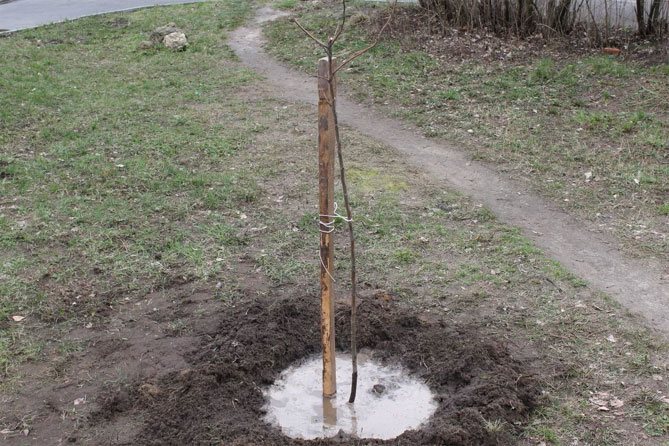

How to plant with a closed root system
Planting plum trees with a closed root system at any time of the year has its own nuances, due to the characteristics of such seedlings. Such planting material is sold in special containers with soil and is much more expensive than ordinary seedlings.
Since the roots of the seedling are in moist soil, it can be stored for a long time. Despite the fact that the container contains a fairly mature plant, it can be planted at any time of the year, with the exception of the summer heat.
When planting such seedlings in the garden, they easily take root, because they do not experience stress.
The landing is carried out according to the following algorithm:
- dig a hole 2 times the volume of the plant's earthy coma;
- a drainage layer is laid out at the bottom of the pit;
- an earthen lump of a plant with roots is placed in the recess;
- all voids around the coma are covered with fertilized soil;
- make abundant watering;
- produce mulching of the trunk circle.
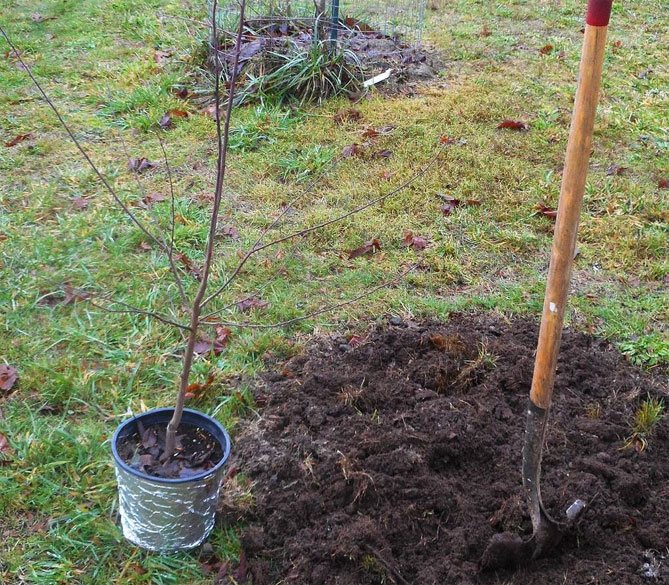

Landing at a high water table
Plum planting is not allowed in low-lying places where water can stagnate and waterlogging occurs. At the plum, the root collar will begin to rot, it will be doomed to death.
It is desirable that in the area allotted for the drain, the groundwater lies at a depth of 3 meters or more. If the groundwater is less than 3 meters away, the plum garden can be laid by making an artificial embankment.

